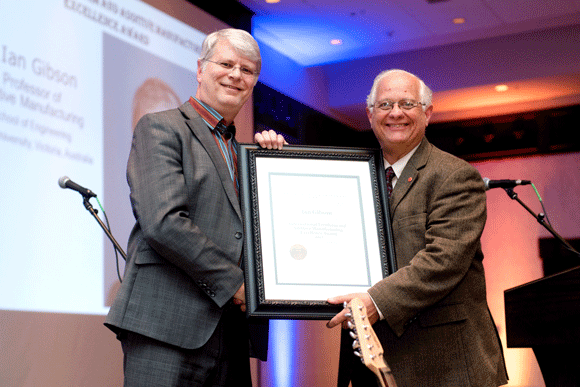Professor Ian Gibson receives international FAME award for achievements in Additive Manufacturing research
August 25, 2017

Professor Ian Gibson (left) received the international Freeform and Additive Manufacturing Excellence (FAME) Award
Professor Ian Gibson, Deakin University, Geelong, Victoria, Australia, has become the first Australian-based academic to receive an international lifetime achievement award recognising his contribution to Additive Manufacturing (widely known as 3D Printing). The International Freeform and Additive Manufacturing Excellence (FAME) Award is given annually and every year recognises one outstanding researcher in the field.
Gibson received the award at the Annual International Solid Freeform Fabrication Symposium in Austin, Texas, USA, in recognition of three of his major career achievements:
- As co-author the textbook Additive Manufacturing Technologies, which has sold more than 250,000 copies worldwide
- As founder of the Rapid Prototyping Journal
- As a leader in professional community engagement, through the establishment of the Global Alliance of Rapid Prototyping Associations and similar initiatives.
Professor Gibson joined Deakin University’s School of Engineering in 2013 and said that since then Deakin had established itself as one of the premier universities in Australia, and worldwide, in the space of Additive Manufacturing.
“Not many others have the facilities and experience to match us,” he stated. “And our approach is different from most others, we have a strong design focus and look closely at how this technology can be applied in a number of other sectors. We have a better understanding of how it interacts with industry.”
Gibson’s research has included a number of metal-focused projects. Speaking to Metal AM magazine, he explained, “I started working in metals about twenty years ago when I was a lecturer at Hong Kong University, where my group had purchased one of the first Rapidsteel tooling technologies in the world.”
“This was a technology that used a steel/polymer blend to create a ‘green’ part using Selective Laser Sintering. The 3D printed part was then transferred to a furnace where the polymer was burnt away and replaced with bronze to create a composite metal part that could then be used as a tool insert.”
More recently, Gibson’s work on metal AM at Deakin University has developed in two primary areas. “We have generated a lot of traction in research into post-processing of metal powder bed parts,” he stated. “This is using our SLM process to create parts that are then studied for machinability, as well as analysing the requirements for heat treatment. This is an area that is of great interest to industrial users of this technology to provide the knowledge to create effective end-use parts.”
The other project on which Gibson is currently working is related to Direct Energy Deposition using Deakin University’s LENS MR-7 machine. He explains, “This process allows us to control the material and energy flow to create functionally gradient parts. These functional properties can be in terms of mechanical variations, like localised strength and porosity or in terms of blending different metals together for even greater variations throughout a 3D printed metal part. This is in its early stages. but the knowledge gained in this research could be far reaching.”
Speaking on the future of Additive Manufacturing, Gibson stated that he had seen the sector become a lot more diverse over his twenty-five years in the industry. It’s nice to feel like you were part of paving the way,” he stated. “I sometimes refer to myself as someone who was looking into 3D printing before it was considered cool. We’re now seeing improvements in quality, materials and speed of build, as well as reduction in price, that’s all making 3D printing a much more competitive option against other technologies.”
















